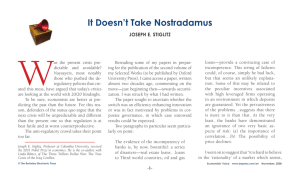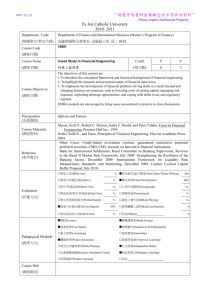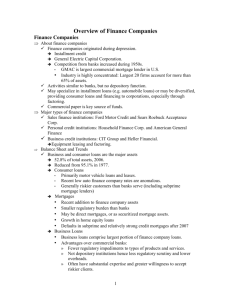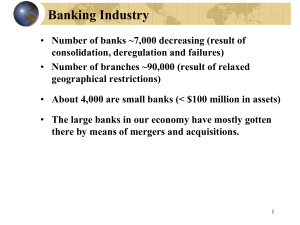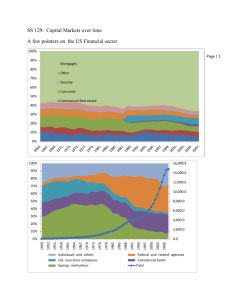Banks - Dipartimento di Economia
advertisement
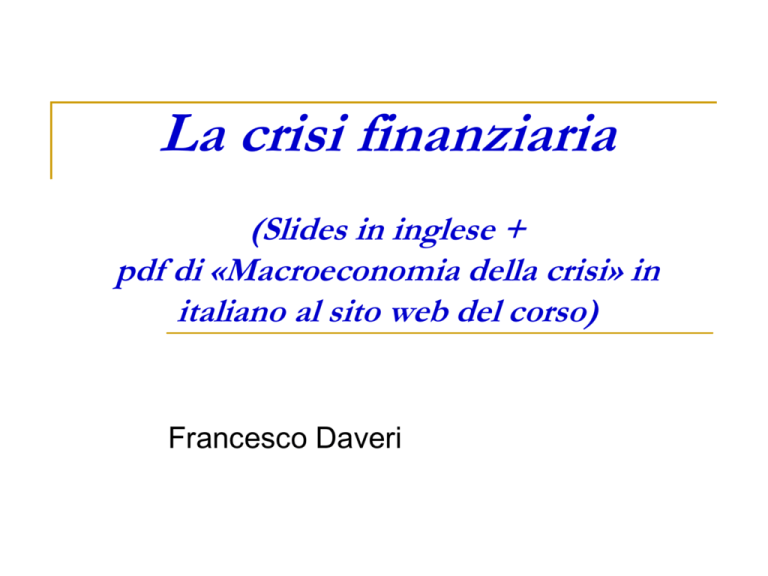
La crisi finanziaria (Slides in inglese + pdf di «Macroeconomia della crisi» in italiano al sito web del corso) Francesco Daveri The timeline of the crisis in one slide • 2008, second half: deepest recession since WWII. Gdp and industrial production went down abruptly in the advanced economies. • A slow recovery started a year later (q3-2009), more strongly in the so-called emerging market economies and only gradually in the advanced economies. • Origin of the financial crisis in the USA in the summer of 2007, then spread to Europe and eventually affected the entire world. Financial crisis originated in the “sub-prime mortgage” market, a part of the US housing mortgage market intended for borrowers with high probability of default. • In these classes we explain how the financial shock was transmitted to the US economy and from there to the rest of the world. • In the next classes we shall describe the “real” side of the financial crisis and the consequences of the macro policies put in place to contain the recession. •These policies: successful in the short run but with less favorable longer-run consequences. Some of these side effects popped up again with the sovereign debt crisis of 2011-12. And next. 2 Crisis, what crisis? Big banks have not seen it Stock market capitalization Bn Us$ HSBC Holdings Bank of America JP Morgan Chase Citigroup Goldman Sachs Dec 31, 2007 197.8 183.1 166.5 146.6 85.5 Sep 23, 2014 196.0 180.2 229.5 160.4 85.2 3 Indeed, there have been a few ups and downs in the stock mkt as well. To be explained. Stock market capitalization Bn Us$ HSBC Holdings Bank of America JP Morgan Chase Citigroup Dec 31, 2007 197.8 183.1 166.5 146.6 85.5 Jan 31, 2009 86.4 39.8 90.6 54.9 33.0 Sep 11, 2009 187.1 147.9 146.6 18.9 83.3 Apr 15, 2011 188.9 129.7 178.7 128.4 84.9 Oct 18, 2011 90.8 61.1 119.8 81.5 49.0 Oct 11, 2012 96.2 101.0 160.8 104.9 60.7 Sep 23, 2014 196.0 180.2 229.5 160.4 85.2 Four puzzles 1. Why the big fall between Dec 2007 and Jan 2009? 2. Why the swift increase between Jan and Sep 2009? 3. Why another big fall again between Apr 2011 and Oct 2011? 4. Why up again between October 2011 and Oct 2012 (and today)? Goldman Sachs 4 Why the four puzzles? Quick answers: (1) Fall after Dec 2007: the market value of mortgage-backed assets – a big part of the asset side of banks’ balance sheet - suddenly and abruptly fell after sudden and abrupt fall in the US housing market, following unprecedented rise. (3) Fall over the summer 2011: still caused by deteriorating asset side of banks’ balance sheet. Yet the source of the deterioration is different: over the summer 2011, perception of riskiness of European sovereign bonds of Greece, Portugal, Ireland, Spain and Italy increased dramatically. Market valuation rallies in (2) and (4) are instead associated with superexpansionary monetary policy of Central Banks The US Federal Reserve playing a leading role in 2009 The Fed, other central banks and the ECB since the end of 2011 Next pages: more details. Bank A and its balance sheet Bank A has • 100 in assets (mortgages, commercial loans, Govt bonds. plus cash) – assets = things that have value and could be sold to raise cash • 90 in liabilities (deposit accounts, bonds issued, other financing) – liabilities = promises to pay money to other people, debt • 10 in capital (= assets minus liabilities) – capital = net amount of value "owned" by common shareholders – set aside to sustain potential losses on assets (computed through statistical techniques e.g. Value at Risk, VaR) NOTE: Accounting rule is fair value: if quality of credit deteriorates, this has to be swiftly recorded in the banks’ balance sheets. 6 Why care about Bank A? Bank A is a TYPICAL bank. Bank A is average US commercial bank before the crisis, with leverage = assets/capital =10. The leverage in investment banks and “hedge funds” was 27. • Lehman Brothers: 25 billions $ of K and 680 billions of assets. • AIG, extended Credit Default Swaps to Lehman, Bear Stearns & other investment banks: 25 of K and 3200 of assets. 7 The higher the leverage, the more profitable (and riskier) the bank Assets Assets Liabilities 300 Capital 10 Liabilities 290 Assets Assets Liabilities 100 Capital 10 Liabilities 90 Leverage = 30 Leverage = 10 Max loss: 3,3% of assets (10/300) Max loss: 10% of assets (10/100) Return on capital: 90% (assuming 3% return on assets and zero costs) Return on capital: 30% (assuming 3% return on assets and zero costs) This is why investment banks such as Lehman were so profitable! Write-offs and credit crunch in Bank A Bank A’s assets are of two types: •60 "good" assets (loans with no default risk) •40 "bad" assets (loans with high default probability. E.g. mortgage-backed securities or Greek Government bonds). At some point Bank A writes off a part of its bad assets, say for an amount of 5. It is thus left with 35 of bad assets whose cash value is, say, 20. After the write-off: Bank A’s balance sheet has 95 in assets, 90 in liabilities, and 5 in capital, so it is still solvent (K=5>0). Yet everybody thinks that sooner or later there will be another write-off of 15 (=3520) in the future. So everybody wants to sell Bank A’s stock. More importantly, no one wants to lend it money, because Bank A borders insolvency. Hence the Bank “hoards cash” and does not lend to people who would need the money to consume and invest. This is the “credit crunch”, how the financial crisis hits the real economy. 9 The rise and fall of the U.S. housing market 10 .. With US sub-prime mortgage delinquency rates and foreclosure rates suddenly up as a result 11 Other countries have been exposed to a housing market sudden reversal: UK, Spain and Ireland Germany and Switzerland: they were not. Source: S&P, Case-Shiller Index. House prices deflated by CPI (consumer price index) 12 The housing market in Italy after Lehman (& Monti) What happened? Why the bubble inflating first, and why then the bursting of the bubble? Before: everything goes up After: everything goes down Hosehold debt up Household debt down Loans made safer (home values up, hence collateral values up) Demand for houses up Housing market prices up Loans made riskier Demand for houses down Housing prices down 14 14 To see why the fall of the housing market in 2007-08 caused so much disruption, need to learn two keywords Sub-prime loans Securitization Keyword 1: Sub-prime loans Sub-prime lending: practice of lending to high-default-risk individuals, higher than “prime” borrowers Low income earners: e.g. unemployed Bad borrowers: imperfect credit history; e.g. divorced single-mother with kids Only in the last few years subprime lending became an important “game in town” 2001-07: 3 trillion $ of mortgages originated each year Share of sub-primes went up from 7% in 2001 to 20% in 2006 At end 2007: total outstanding stock of sub-primes was some 1.4 trillions $. The share of defaulting subprime loans (by year of mortgage approval) boomed in 2006 and 2007. 16 Sub-primes economics: How sub-prime lending works? Sub-primes = adjustable-rate mortgages with “hybrid structure”, partly variable and partly fixed rates Example: 30-year mortgage; may be of “2/28” type • A fixed rate for the first 2 years, incorporating a premium (say: 6 ppts) over benchmark interest rate (LIBOR); • then switch to variable rate for the residual 28 years. After switch, often much higher monthly payments. 17 Why be a “sub-primer”? Why should an unemployed, with wife and dependent sons, be so short-sighted to enter a contract like this? All depends on the appreciation of the US housing market “Sub-primers” allowed by intermediaries to refinance their mortgage before the switch against increased house value. So as to avoid (or postpone) default Refinancing made 50-70% of new yearly mortgages in 2004-06 Sub-primers would also stick to the same intermediary for subprime contracts typically entail very high initial pre-payment fees (exactly to discourage intermediary!) 18 As such, though, the sub-prime problem and the related house price shock was relatively small Black Monday (October 1987) S&P 500: - 20 % 2008 U.S. house price, - 30%. bank losses on mortgages: US$650 billions equivalent to a 4% fall in S&P 500 Mortgage securitization 20 “Mortgage securitization”: in words • Mortgage contracts are differentiated over time and between borrowers (house location, borrower’s profile, lender’s marketing strategy). Yet financial markets may transform heterogeneous mortgage contracts in homogeneous products. • Purpose: achieving RISK DIVERSIFICATION • By issuing a mortgage to a borrower, a bank creates an asset that gives right to cash flows paid regularly over time. • Securitization occurs when these cash flows are sold to a Special Purpose Vehicle (SPV) administered by a financial institution: – Given that borrowers may default, value of this asset is risky for the SPV. Then SPV holds diversified portfolio of such assets, pooling together many borrowers with similar risks under some dimension, but not identical – The SPV finances its purchase of cash flows by issuing securities (here is “securitization”!) called Mortgage Backed Securities (MBS), the biggest part of ABS (Asset-backed securities) in the US. 21 From risky mortgages to “asset-backed securities” (1) • How can this be? How can risky cash flow be turned into standardized “asset-backed securities”? • Trick: cash flow from well-diversified pool of mortgages is a cake that can be cut into slices (“tranches”) of increasing risk/return profiles in a Collateralized Debt Obligation (CDO). • Then: the cash from the pool of assets is used to pay interest & principal to the tranche with “senior” status; the remaining cash goes to pay the holders of the second tranche, with intermediate status; and so on. • By appropriately choosing the loss threshold from which the senior creditor is exempted, the SPV may generate at least one tranche of “AAA securities” that can be certified by a rating agency. Then there will be other tranches involving increasing risk and rated “AA mezzanine”, “BBB subordinated” and “first-loss position” (the “garbage”). 22 From risky mortgages to “asset-backed securities” (2) • Goal of the process: transform a bunch of heterogeneous risky mortgages into the largest possible pool of standardized, high-rating Asset-Backed Securities. • Often certified by rating agencies (in conflict of interest for paid by the administrator of the SPV). Moreover, given that rating agencies set different criteria to award an AAA status, SPV would also shop around to find the rating agency with the easiest-to-satisfy criteria. • On top of that, such securities have often been insured with insurance companies (Credit Default Swaps, CDS). Example: AIG, American Insurance Group, bailed out one day after Lehman has gone under. • Finally, liquidity was an essential ingredient of the overall process: the ABS was usually of a shorter maturity than the underlying mortgages. Hence, they had to be rolled over issuing new securities. 23 Sub-primes economics and securitization – Keywords Heterogeneous mortgages Standardized Asset-Backed Securities (ABS) sliced in tranches with different risk/return profiles (CDO) Certification by rating agencies ABS insured with insurance companies (Credit Default Swaps, CDS) Roll-over financing implied, liquidity crucial to the whole system 24 Securitization may also be seen in pictures … Learn about securitization from a messy picture with lots of acronyms … CDO’s Bank CDS’s Cash loans AIG Conduits, Special investment vehicles AB commercial paper CDO’s Cash Investors … Or through an enjoyable cartoon … Click on the following link and learn about securitization the easy (but deep!) way The subprime primer: http://www.slideshare.net/guesta9d12e/subprime-primer277484 26 The spectacular rise (and fall) of asset-backed securities Global issuance of asset-backed securities (a) Source: Dealogic. (a) Quarterly issuance. (b) Commercial mortgage-backed securities (CMBS) (c) Residential mortgage-backed securities (RMBS). ‘Others’ includes auto, credit card and student loan ABS. 27 Derivative contracts – what they are for Think of a Multinational company For companies that become big and global, financial uncertainties inevitably creep in: in foreign exchange valuation In the interest rate paid on debts or earned on deposits, In inflation In commodity prices of raw materials. An unavoidable cost of doing business to be taken as such? Or something to be gotten rid of. How? Using DERIVATIVES financial products aimed at shaping, reducing, or perhaps even increasing the different flavors of financial uncertainty 28 Most derivatives are interest swap contracts 504,098 500 Billion of $ 400 300 200 100 5,982 28,633 42,609 Credit default swaps Other assets 63,349 45,9 69,659 0 Commodities & Stocks Foreign exchange Interest rate World stock World Gdp swaps mkt capitalization Huge numbers 14 times as much as the value of the world stock markets 9 times as much as the value of world Gdp 29 Interest rate swaps Consider the uncertainty in how companies borrow and invest cash. A treasurer might tap short-term money markets in three-month stints, facing the uncertainty of central bank rates spiking up. Or they could use longer-term loans that tracked the interest rates paid by governments on their bonds, perhaps getting locked into a disadvantageous rate. Imagine that once you had committed yourself to one of these two financing routes, an invisible toggle switch allowed you to change your mind, canceling out the interest payments you didn’t want to make in return for making the payments that you did. This is the interest rate swap, the world’s most popular derivative 30 The rising value of derivatives has made trading and securitization much more important items on the asset side of banks’ balance sheets LCFIs= Large Complex Financial Institutions Finance often blamed for creating a “paper economy” which doesn’t spill over to the “real economy” --Let’s see what happened “Risk diversification” through derivatives fed into much increased credit availability to the economy (households and companies) ... ... also as a result of much lower borrowing costs for companies issuing bonds The “illiquidity risk” fell considerably (the disappearance of the orange area means that the illiquidity risk premium went to zero) And credit from policy makers was also very cheap … 20.00 18.00 16.00 dot-com crisis in grey 14.00 12.00 10.00 8.00 AG feeding the bubble 6.00 4.00 2.00 0.00 1987 1989 1991 1993 1995 1997 1999 2001 2003 2005 2007 Composite-10 Case Shiller housing index (Jan. 1887 = 5) Federal Fund rate Alan Greenspan (AG) kept the discount rate “low” for too long in 2003-04. Perhaps. We will come back to this when discussing monetary policy. 35 Question: how have firms used the rivers of available liquidity? LBOs, Mergers and Acquisitions, e IPOs “Indignados”, “Occupy Wall Street”, “Movimento Cinque Stelle” and others question whether all this has been worthwhile at all. Results from Leveraged Buy-outs (LBOs)? Davis, Haltiwanger, Lernet et al (2014) • Allegation: LBOs (Leveraged buy-outs) produce high profits for managers and private equity funds, employment cuts andlittle value for the firm The facts Data for 3200 companies, 150 thousand plants, 1980-2005 1. Employment falls by 3% with respect to comparable plants in target firms in the two years after the buy-out; by 6% in the five years after the buyout • Yet the newborn companies (from the merger between the Newco and the target) end up creating +2% of jobs more than comparable firms and plants. • Netting out pluses and minuses, average job loss for target firms is 1% in the two years after the LBO • Overall, the gross creation and destruction of jobs goes up a lot (+14%) with respect to comparable firms 2. Plant productivity goes up by 2,1 per cent in the two years after the LBO. Yet productivity gains mostly stem from closing down of old (obsolete?) plants and opening up of new plants, rather than from reorganization of existing plants 3. Profir margins: gain, as a result of a 2,5% fall in earnings per worker in the two years after the LBO Summing up: the timeline of the crisis Fall of housing prices 1. Losses in banks’ capital, risk of illiquidity or outright insolvency because of extensive securitization of sub-prime loans 2. “Deleveraging” (reduction in leverage) via i. Reduction in loans (“credit crunch”) ii. Selling of liquid assets (in turn causing further fall of their market prices) iii. Market re-capitalization (up to June 08) 3. Lehman Brothers goes bankrupt (15/09/08) i. Freezing of interbank market and extension of public guarantees (Sep 08) ii. Asset burning and acceleration of asset deflation 4. Fall in household housing and financial wealth, postponement or cancellation of durable consumption and investment, falling aggregate demand and policy response (Oct 08-) The Paper Economy or how the shadow banking system operates The process described so far operated through a Parallel (or Shadow) Banking System The parallel banking system is made of all the non-bank financial institutions (including investment banks) taking part in the process of credit creation for the rest of the economy. (Names? Bear Stearns, Lehman Brothers) What did the parallel banking system do? Financed vast amount of real estate lending and consumer borrowing Made loans with no deposit base Used little operating capital and extremely high leverage ratios (=assets/capital). As a result, lots of profits Extended loans usually securitized and traded among financial firms 40 Where did such pressing credit needs come from? Mario Draghi (then Bank of Italy Governor) “Credit has become something to be bought and sold in the market instead of being held onto the balance sheets of financial intermediaries” Response to well known myth in the American society: the idea of the “ownership society” Founding myth of the US society Revived by GW Bush 41 Greenspan’s endorsement of leveraged finance Alan Greenspan (Fed governor before Ben Bernanke, from 1987 to 2007) famously said in 2005 “The new instruments of risk diversification allowed bigger and more sophisticated banks … to get rid of the bulk of credit risk by shifting it to less exposed institutions. These increasingly complex financial tools have contributed to the development of a more flexible and efficient financial sector, hence less exposed to shocks than the one that existed only twenty five years ago. After the bubble bursting of the stock market in 2000, no major insolvency of any big financial institution, at odds with what happened in the past in the wake of big financial shocks” (italics are mine) Yes, the Maestro said: “LESS EXPOSED INSTITUTIONS” and “LESS EXPOSED TO SHOCKS” 42 Was Alan Greenspan crazy? Or may be simply captured by investment banks? No. Simply, “modern” (leveraged) finance has its pros Expansion of financial markets financial development economic growth Thanks to pooling and distribution of diverse risks How? Investor portfolios more diversified through creation of new financial products entailing different risk-return combinations Reduction of ratio between required bank capital and originated credits More loans for given capital, more credit, more profits As long as things square well .. 43 The wrong side of the parallel banking system A fragile business model Natural mismatch of maturities – implicit in the functioning of modern credit systems - stretched to an extreme Loans are long term but their funding is short-term. Both with banks and parallel banking system Non-banking institutions particularly vulnerable to disruptions of money market funding, for their business model based on really short-term roll-over of funds Moreover, securitization converted loans into financial instruments to be priced according to market conditions OK, as long as home prices kept rising When home prices fell, firms had to take large “mark-tomarket” losses Given low capital ratios, losses quickly wiped out firms’ thin capital bases, thereby leading to a freeze of roll-over funding 44 Why the incentive system in place was distorted? (1) Banks interested in cashing hefty fees for structured sophisticated financial products Less interested in monitoring the quality of credit (risks distributed to outside takers) or borrowers’ behavior Brokers Paid according to quantity of procured credit; in search of the mortgage taker with no evaluation of creditworthiness Rating agencies supplied consulting on how to structure financial products whose quality they were supposed to evaluate Rating based on “optimistic” statistical models Two reasons for optimism: (a) rating based on recent (typically: two) “good” years and (b) no regard given to liquidity risk of “unusual” financial products 45 Why the incentive system in place was distorted? (2) Fund managers and desk traders fee structure based on principle Heads I win, tails you lose contributed to take excessive risk taking Being a senior executive at an investment bank, even if you knew you were in a bubble that was going to collapse, it was still in your interests to play along For at least two reasons the enormity of the short-term compensation to be made outweighed the financial risk of being fired in a bust (given severance packages, and the fact that in a downturn all CEO compensation would plummet) bucking the trend entails “CV risk” in such a way that playing along doesn’t 46 The US Financial sector reform after the crisis US Financial sector reform enacted http://topics.nytimes.com/topics/reference/timestopics/subj ects/c/credit_crisis/financial_regulatory_reform/index.html Global credit crisis in 2008 called for financial sector reform July 2010: Congress passed Dodd-Frank Act expanding the govt role in fin’l mkts, reflecting mistrust on the part of politicians after decades of wide-eyed admiration of Wall Street Since then: stock market back up, banking profits back up, economy is moving ahead So: is enacted financial reform ok? 48 Dodd-Frank Act in a nutshell The Dodd-Frank Act aims to tackle abusive lending practices and high-risk bets on complex derivative securities that nearly drove the banking system off a cliff It creates a bureau to protect consumers from fin’l fraud It cuts fees banks charge for debit-card use It calls public exchanges on which derivatives and other complex financial instruments are traded Also included is the so-called “Volcker rule” Rule, named for Paul Volcker, the former Federal Reserve chairman who proposed the measure in early 2010, restricts ability of banks whose deposits are federally insured from trading for their own benefit. This is to counteract creation of TBTF (Too Big To Fail) institutions 49 Lags of implementation Hundreds of important decisions to be worked out in one of the most complex processes ever undertaken by govt By Sep 2011 only small portion of the law has taken hold. Of the up to 400 regulations called for in the act, only ¼ had even been written, much less approved. Key targets of opponents Too big powers of Consumer Financial Protection Bureau Too strict limits on debit card fees Too generous budgets for S.E.C. (the US Consob) and Commodity Futures Trading Commission 50 Huge costs of implementation Dodd-Frank (DF) Act: 848 pages Example of legislative inflation US banking system set up in 1864 with law of 29 pages; the Fed established in 1913 with 32 pages; the Glass-Steagall Act that enabled the shadow banking system to be so profitable spread out to 37 pages Problem is not just length: sections 404 & 406 (to limit risk exposure of TBTF institutions) add up to 2 pages only Yet form based on such law provisions to be filled out by hedge funds and other firms ran up to 192 pages Cost of filling it out? According to informal survey of hedgefund managers, $100-150.000 in 1st yr and $40k in later years Same for Volcker rule: 11 pages of DF became 300 pages of proposal and up to 1420 questions to be answered by firms 51 Is the new web of agencies making the occurrence of the next fin’l crisis less likely? 52

